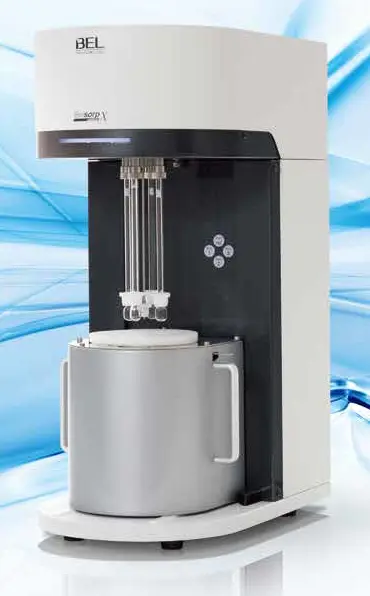
Practical BET measurements
This is a very brief list of some considerations before running BET measurements. If you would like more detail about using your BELSORP for BET analysis, contact us.
Understand your instrument.
- How the AFSM function works
- or maybe your instrument uses some other method of free space control
- Know the sensitivity and accuracy
- What is the recommended sample size
- Has the instrument been serviced ? Was a reference sample run recently ? Or other controls ?
- …
Know your sample
- Can it be heated ? Can it be exposed to vacuum ?
- Does it contain any solvent or water ?
- The effect of heating may be far greater when solvents are present.
- It may be necessary to degas in several stages, starting at low temperature, and progressively increasing.
- How long must it be degassed ?
- Does it contain evaporable components ?
- Even metals, such as Zinc and Magnesium can evaporate when heated in vacuum.
- Is there a risk of damaging it ?
- Heat can cause damage to polymers and other organic compounds
- Heating zeolites which contain water can cause hydrothermal decomposition
- Cements, clays, silicates, and many related materials
- Residual solvents can decompose MOF-type materials
- Natural biomaterials can crack and deform when dried
- Heat can also cause structural changes:
- Recrystallisation after heating above the Glass transition temperature
- Strain relief and annealing of disorder
- Could there be any pores ? What sizes ?
- If you want to get knowledge about the pores, it is necessary to measure at suitable pressures
- The presence of micropores normally increases the difficulty of outgassing.
- What form is it ?
- If it is granular or monolithic :
- Does it fit inside the cells ?
- Is it necessary to grind or cut it ?
- Is it necessary to use it whole ?
- If it is a powder :
- Is there a problem of elutriation - movement of the powder when vacuum is applied ?
- Is there a problem of static adhesion on the sides of the cell?
- If it is granular or monolithic :
- Do you already know what BET surface area you expect ?
Choose the analysis conditions
- Sorptive and temperature:
- Nitrogen 77 K
- Argon 77 K
- Argon 87 K
- Krypton 77 K
- Water at 298 K
- Other vapors
- Select an appropriate amount of sample
- Typically, your manufacturer will indicate a minimum amount of surface area in the cell.
- Remember there are other considerations in choosing sample size…
- cell and accessories
- degassing and sample preparation method
- measurement method
- use AFSM
- Use GDO ?
Verify your equipment
- Clean cell, frits, cell caps/ autoseal valves
- Caution : In case of static problems, the cleaning method may be contributing, if the detergent leaves silicone or other residues.
- New seals or o-rings ?
- Recent verification of instruments ?
- date of last periodic BELSORP system-check.
- last measurement of a reference sample
- last service of pumps - especially rotary pumps where a turbomolecular pump is not used
- Verify the laboratory microbalance
Loading sample
- Prepare the empty cell - it must be clean and dry
- It may be necessary to evacuate and backfill it with inert gas
- Some samples absorb significant amounts of nitrogen, even at room temperature, so it may be necessary to use helium at every weighing stage
- Weigh the empty cell
- Load the sample
- avoid sample in the stem of the cell
- Weigh the sample + cell, before any outgassing
- Evacuate or purge
- Verify there are no leaks
- Degas
- External degasser? in-situ? both?
- Set the correct Temperature
- or temperature profile
- Record the duration of degassing
- Verify the apparent leak rate
- Cooling
- Backfill the cell with the same gas used for the empty weighing
- Reweigh the sample when the moisture has been removed
Configure the measurement
- Measurement of the value of \(P_0\) ( saturated vapour pressure )
- Measurement range of \(P\) or \(P/P_0\)
- Must at least cover the BET range
- It is very useful to include desorption points
- If the adsorption interaction is truly physisorption, then the desorption curve should superpose the adsorption curve - it should be reversible. Otherwise, there may be a problem with the measurement.
- Do you want to include a full isotherm to see details of the mesopores ?
- Dosing criteria
- Equilibration criteria
- These are especially important for measurements of microporous materials at low pressures, where the equilibration can be very slow.
After the measurement :
- Verify the reversibility within the BET range (or understand why the isotherm is not reversible)
- Verify that the \(C\) constant is positive : \(C \gt 0\)
- Choose the region where the BET model is valid
- Specifically, \(n_{ads}\,\left(1 -
P/P_0\right)\) should be increasing continously with \(P/P_0\)
- This is recommended by ISO9277 / IUPAC - it is commonly called the Rouquerol criterion
- It is particularly important in the presence of micropores
- Specifically, \(n_{ads}\,\left(1 -
P/P_0\right)\) should be increasing continously with \(P/P_0\)
- Verify that the relative pressure \(P/P_0\) corresponding to the monolayer coverage, \(n_m\), lies inside the range of \(P/P_0\) used for the fit.
- Choose A_m
Reporting the result
Explicit mentions to accompany the BET area:
- Gas species
- Temperature
- Outgassing conditions, duration, verification method
- Range of \(P/P_0\) used for fitting
- and why that range was chosen
- Quality of fit, usually as an R^2 value
- The C value